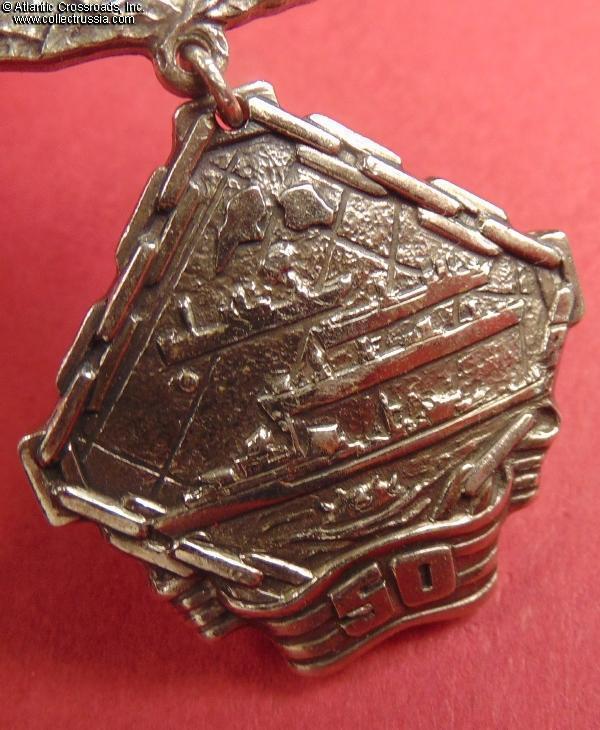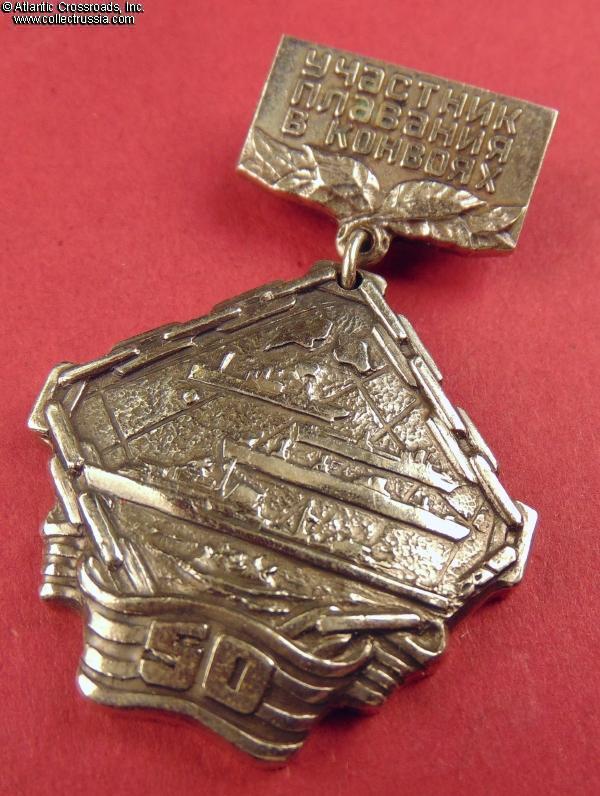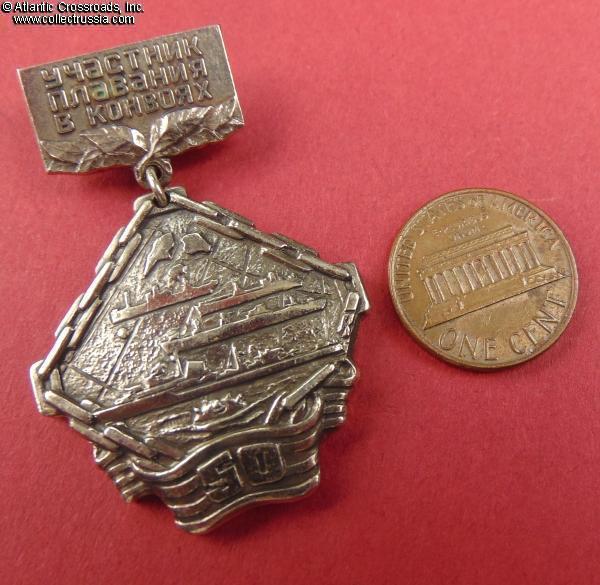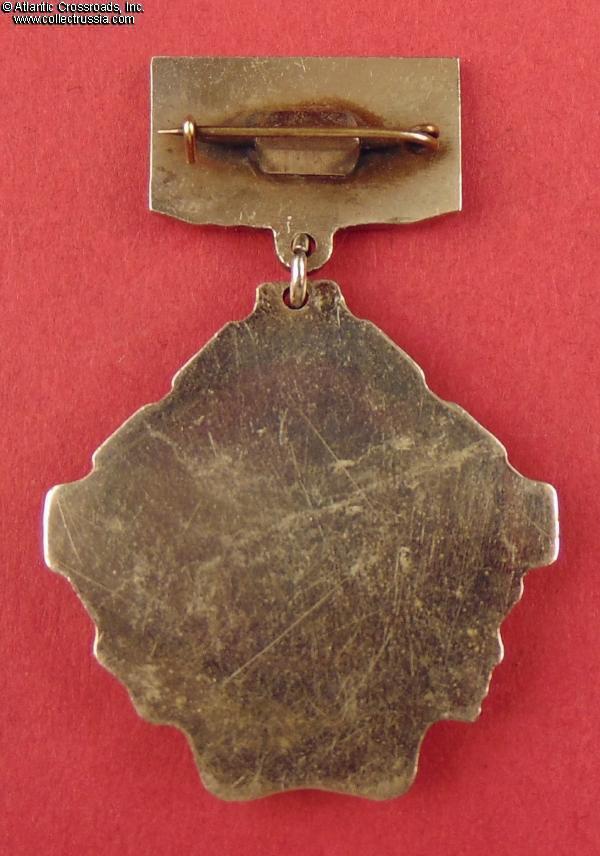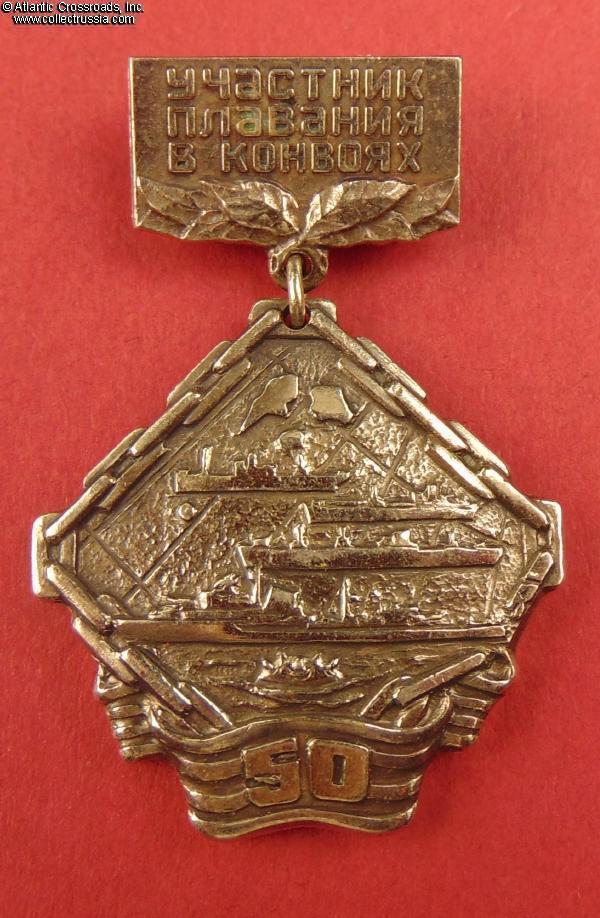
Badge of a Participant of Northern Convoys, August 1991 issue in Commemoration of the 50th Anniversary of the Arrival of the First Allied Convoy into the Port of Arkhangelsk (PQ 0 "Dervish").
In German silver, an attractive and massive piece. The pendant measures 32.5 mm wide. Attractive artwork featuring merchantmen and a warship braving the northern latitudes and floating mines, with an anchor chain along the edge. The inscription on the suspension is "Participant of Sailing in Convoys."
The badge was awarded in August 1991 to WW2 veteran sailors invited to Arkhangelsk to celebrate the anniversary (the visit coincided with the attempted coup against Gorbachev which directly led to the dissolution of the USSR later that year.) The design
In German silver, an attractive and massive piece. The pendant measures 32.5 mm wide. Attractive artwork featuring merchantmen and a warship braving the northern latitudes and floating mines, with an anchor chain along the edge. The inscription on the suspension is "Participant of Sailing in Convoys."
The badge was awarded in August 1991 to WW2 veteran sailors invited to Arkhangelsk to celebrate the anniversary (the visit coincided with the attempted coup against Gorbachev which directly led to the dissolution of the USSR later that year.) The design of the badge was based on a similar badge awarded a few years prior to foreign and Soviet participants of the perilous arctic voyages.
The role of the Lend-Lease convoys in the ultimate victory in WW2 can hardly be underestimated. For instance, some 20% of all aircraft, 12% of larger tanks and 100% of armored personnel carriers in Soviet WW2 inventory were supplied by the British and American allies - not to mention tremendous amount of food, raw materials and pretty much everything else from railway cars and trucks to radioactive isotopes. What's more, they came in the most critical time during the Blitzkrieg, when much of the industrialized western part of the USSR had been overrun and the war factories evacuated east into the Soviet interior had not yet resumed full production.
Soviet historians later downplayed the importance of Lend-Lease program creating a popular myth that the Patriotic War would have been won anyway without it. In reality, it almost certainly would have been lost considering the crucial timing. The notion of inferior quality of western equipment is likewise contrary to historical facts. For example, some of the best Soviet armored units switched in the middle of the war from the supposedly superior T-34s to Shermans, many of the top Soviet fighter aces and bomber pilots enthusiastically eschewed domestic aircraft models in favor of Bell P-39 Airacobras and Douglas A-20 Bostons, and the armies of Soviet drivers replaced Soviet vehicles with the far more capable and reliable Studebakers and Willys'. Stalin, for one, obviously held pretty high opinion of the western help: one of his orders issued in October 1941 at the opening of the Battle for Moscow was to create and train two air regiments equipped with Spitfires - that were still in route from the Great Britain at that point.
The first supplies were delivered by British sailors into Arkhangelsk on the 1st of August 1941, followed by the arrival of the first small convoy PQ 0 "Dervish" before the end of the month. For the first months of the war, the Germans paid little heed to the ever-increasing stream of supplies into the Soviet northern ports, attempting first to capture Moscow and quickly win the war, and then trying to capture Murmansk or destroy from the air the ports and their railway lines leading south. The situation had changed drastically in the spring of 1942 with the arrival of Kriegsmarine battleships and submarines as well as large number of Luftwaffe bombers. Beginning with the PQ-13 and -14, the Arctic convoys started to suffer heavy losses that culminated in the nearly complete destruction of the infamous PQ-17. After a brief pause to strengthen their defenses and logistics, the convoys continued to sail unabated throughout the war. Although supplemented by traffic via Iran, Alaska and increasingly through the Pacific maritime route, the northwestern Lend-Lease corridor remained the most important due to its proximity to the main theater of war. This medal awarded to one of the participants of the dangerous effort is an extremely interesting and historically significant piece.
Please note, penny in our photo is for size reference.
$150.00 Add to cart

